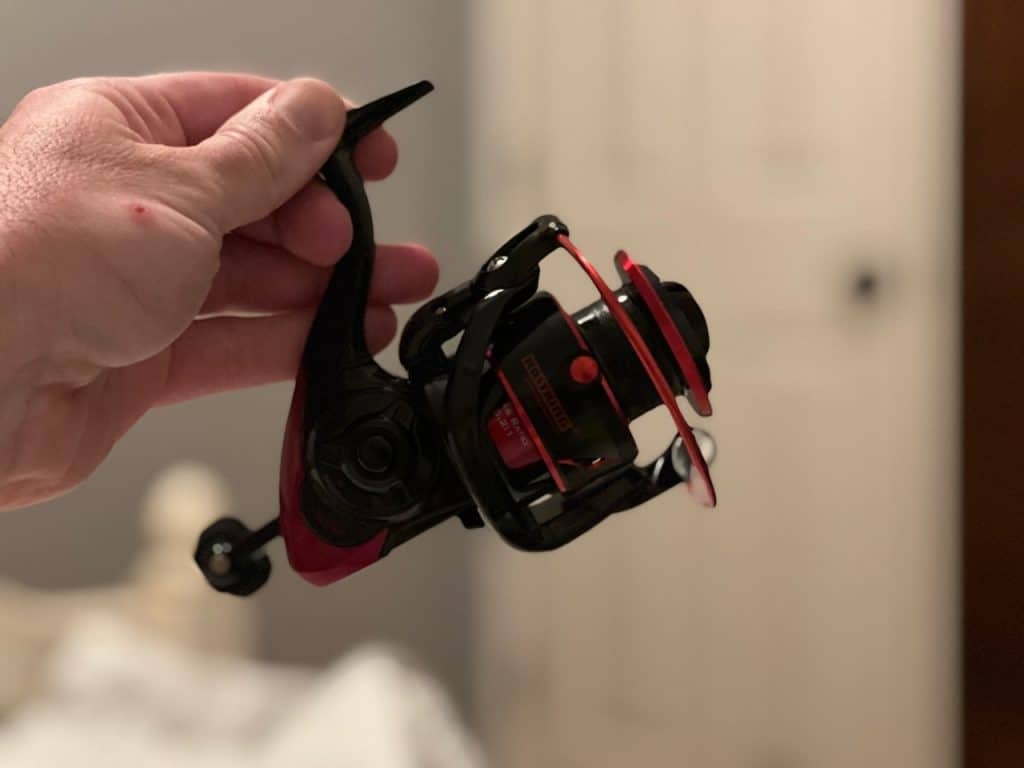The KastKing Sharky III and the KastKing Baitfeeder 3 are very similar fishing reels with one major difference!
What’s the biggest difference?
The KastKing Baitfeeder Sharky III has bait feeder functionality. Think of this as a secondary drag system on the back of the reel that allows a fish to pick up your bait and run with it with little to no residence until you engage the reel, which defaults the reel back to the main drag and sets the hook.
Intro: I own these products!
If you’re reading this comparison, you’ve most likely narrowed down your search for your new spinning reel to two options, the KastKing Sharky III and the KastKing Sharky Baitfeeder 3. I’ve got great news for you! I own both and I’ll try to do a very simple, clear comparison below that will hopefully help you make the final decision that’s best for you!
The Difference in Max Drag
There is a slight difference in max drag between the KastKing Sharky III and Baitfeeder Sharky. It’s not a huge gap and probably wont take a difference unless you are fishing for species that weigh over 25lbs and are using line with a test of 25lbs or more.
The Sharky III has a max drag of roughly 35lbs depending on the size whereas the Baitfeeder Sharky 3 is around 25lbs depending on the size. So you give up just a little in max drag by picking up the baitfeeder functionality.
With that said, both of these reels will be able to slay monster bass, big catfish, most redfish and even most bull red drum, flounder, trout, etc. 25lbs is a big darn fish!
The Difference in Handle
The Baitfeeder has a slightly nicer, T-Handle design. There’s not much else to say besides the fact that the Sharky III’s handle is not necessarily inferior, just a different basic knob sized EVA handle and the Baitfeeder’s handle is a slight upgrade.
The Biggest Difference

As mentioned at the top of this comparison, the Baitfeeder functionality is the biggest difference between these two models. If you’re not familiar with baitfeeders, they are secondary drag systems in essence. They allow you to set a loose initial drag on your line that has a loud audible click when a fish hits your bait. You can set the baitfeeder resistance at zero or tight it up some so the fish has just a little bit of initial resistance. One the fish takes the bait and hook and begins to swim off, you’ll hear that audible initial drag (the baitfeeder) at which point you can let it run a little or go ahead and engage. Once you engage, the bait feeder is bypassed and the main system drag comes into play. This should help set the hook and you can then go ahead and fight then hopefully land the fish.
My Honest Thoughts on Baitfeeders in General
I personally think baitfeeders are a cool concept and have buddies that love them. I will occasionally use a baitfeeder, but usually not, simply because I like to keep things as simple as possible when fishing.
I can see the convenience of being able to have a primary and secondary drag, but I am already used to manually doing this. I will typically leave my drag pretty loose when working my lures or live bait though the water and then as soon as a fish hits, I instinctually tighten my drag. So call me old-fashioned, but I dont really need the added functionality of the baitfeeder.
My Conclusion and Recommendation
If you think the Baitfeeder functionality is cool and something you want and will actually use, go with the KastKing Baitfeeder Sharky III. But, if you dont think you’ll need or use that added functionality, I would say stick with the KastKing Sharky III and keep things simple!
Tight Lines and thanks so much for visiting my website!
Sincerely,
Make sure to check out my hand-picked list of the Best Spinning Reels this year!
[content-egg module=Youtube]
Additional Questions
What is the most precise type of fishing reel?
A Baitcasting Reel sets the benchmark when it comes to the precision of fishing reels. Hailed as the epitome of advanced technology in the realm of fishing, it’s no surprise that professional anglers swear by it. The sheer power of a baitcasting reel complements its unparalleled precision to offer an unrivaled fishing experience. As someone who has been fishing for years, I can attest that a baitcasting reel provides the kind of control and accuracy that is virtually impossible to achieve with other types of reels. However, mastering a baitcasting reel does require some skill and practice. But the payoff in the form of pinpoint casting and muscle to reel in those big fishes is totally worth the initial hurdle. As a friend and mentor of many in the angling community, I often tell them to not let the complexity of a baitcasting reel intimidate you. With some patience and practice, you’ll definitely grow to appreciate the precision it brings to your fishing exploits.
How do you operate a baitfeeder spinning reel?
Operating a baitfeeder spinning reel is easy once you get the hang of it. The first step is to rig the reel with the line and the bait. The bail arm should be in the open position when you begin. Hold the reel stem between your middle and ring finger, and make sure the line is held lightly with your index finger. You’ll feel a rewarding thrill as you cast the line and flip the bail back into place with a quick turn of the reel handle. The baitfeeder function comes into play once the bait has settled in the water. This feature allows the line to run freely when a fish bites, without the need to open the bail or disengage the reel handle. The reel’s drag system also adds a level of balance between hooking the fish and applying just the right amount of tension to prevent the line from breaking. A spinning reel has been my trusted companion on many fishing trips, and I can safely say that the challenge lies not in operating the reel, but rather in the excitement and anticipation of catching your prize fish.
